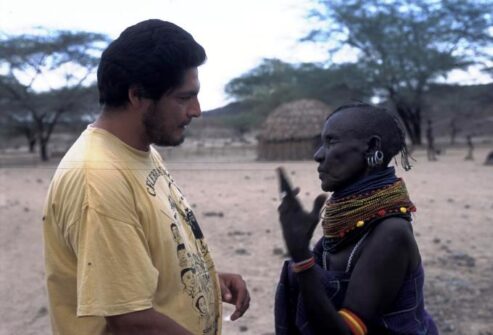Mexico. A Sound that Calls for a Missionary Commitment.

The Comboni magazine ‘Esquila Misional’ celebrates 70 years of life. At the service of the people and of the Mexican church
open to the world.
It was a mild Thursday afternoon of January 22, 1948, when the first five Comboni missionaries landed at the Tijuana airport in Baja California. Waiting for them was Msgr. Felipe Torres Hurtado, apostolic administrator of the Vicariate of Baja California. With him, they went on to the city of La Paz. From the beginning, their presence stood out for being discreet and available to people’s needs. Three years later the Combonis assumed responsibility for the church of Tetepan in the parish of Xochimilco south of the capital city of Mexico. The idea was to start a work of vocations promotion for the formation of future Comboni missionaries and missionary animation.

Father Fernando González, with experience in South Sudan.
In 1953 they opened a training house in the Moctezuma neighbourhood and on January 1 of the same year the first issue of the magazine ‘Las Misiones’ was published, which in September would take the name ‘Esquila Misional’. Father Elio Sassella, founder and first director, explains the choice of the name: “Esquila is the smallest of the bells of a temple. It wants to call everyone with its vibrant voice. The purpose of Esquila Misional is to awaken and call the whole Catholic world to the arduous task of saving souls in the field of foreign missions. We all can and must be missionaries. Therefore, Esquila Misional wants to be a call to spread the Kingdom of God”.
The first issue consisted of only 16 pages. The contents were the experiences of the Comboni missionaries in Africa. In 1962 the number of pages was increased, and it was enriched with new sections. The magazine accompanies the changes within the church. In 1966, to spread the missionary idea among children, ‘Aguilucho’ was born.
In 1967, encouraged above all by the wave of ecclesial openness promoted by the Second Vatican Council and, in particular, by the conciliar decree Ad gentes, Esquila Misional made a significant leap in form and content. The number of pages increased to the current 52 and became more universal, in the sense that its contents no longer concerned only the Comboni missions in Africa or America, but reported the missionary reality of the whole world. With the inauguration of the Centre for Missionary Animation (CAM) in 1976, other publications were founded around Esquila Misional: books, pamphlets, rosaries, audiobooks, etc.

Sr. María de los Angeles Funes Rodríguez, vicar general of the Comboni Missionaries Sisters.
Thanks to technological advances, the magazine improved over time, both in the quality of the paper and in the printing of texts and photographs.
In March 1997, Esquila Misional reached the mythical milestone of 500 issues, which was celebrated with the introduction of colour for the first time on the internal pages. At first, half the pages were colour, then in May 1998 the definitive leap was made, where the 48 internal pages and the covers began to be published in colour, as they are today.
Esquila Misional not only informs but is a strong tool for vocational promotion. Father Fernando González, a Comboni missionary with experience in South Sudan recalls: “I began to read Esquila Misional when I attended catechism in the parish. I was very interested in the part of the magazine where the ‘Letters from the mission’ were. As I read, I imagined missionary adventures, sometimes imagining myself in Africa. Even though I have done a lot of apostolate in my parish and in my diocese, when I heard the call of Jesus, I didn’t hesitate to become a Comboni Missionary. Esquila Misional was the tool through which I discovered my missionary vocation”.
For Sister Tere Soto, a Comboni missionary who works in Chad, reading Esquila Misional gave rise to her desire to give her life for the mission. “I liked reading the section ‘Girls looking for something valid’. The example of many missionaries has touched my heart deeply. God used the magazine to help me answer his call to go into all the world to proclaim the Good News to the peoples”.
Sr. Josefina López, a Comboni Sister working in Costa Rica: “Through a friend from Guadalajara I got to know the magazine Esquila Misional in 1976. I read the testimonies of men and women religious who made me dream of missionary life. Knowing the life of the founder San Daniele Comboni, my interest in the African continent was born, and grew. On August 18, 1977, I entered the postulancy of the Comboni Missionary Sisters in Ciudad Granja, Jalisco. Thank you, Esquila Misional, for being the tool that opened me to the African continent, for being the tool that opened the doors of mission to missionary happiness!”

Fr. Rodríguez Perez Pablo Simón working among the Turkana people in Kenya.
Today Esquila Misional is much more than a simple magazine; it is a whole series of publications and activities aimed at the missionary animation of the Mexican people.
On the other hand, the arrival of the Internet has brought about new possibilities for the media and for missionary animation.
Esquila Misional did not want to miss the opportunity offered by this new technology and, after various attempts and trials, it has finally begun its journey through the networks with its website and its presence in the different social networks. The website was launched in the first years of the new millennium, a Facebook account was opened in 2013, and an Instagram account in 2021. In the past year, the YouTube channel has been relaunched and updated, where videos and missionary testimonies are shared, and a TikTok account is expected to be launched in 2023. Through all these means, Esquila Misional continues to ring the missionary bell to encourage the people and the Mexican church to be open to the world.
(C.C.)



